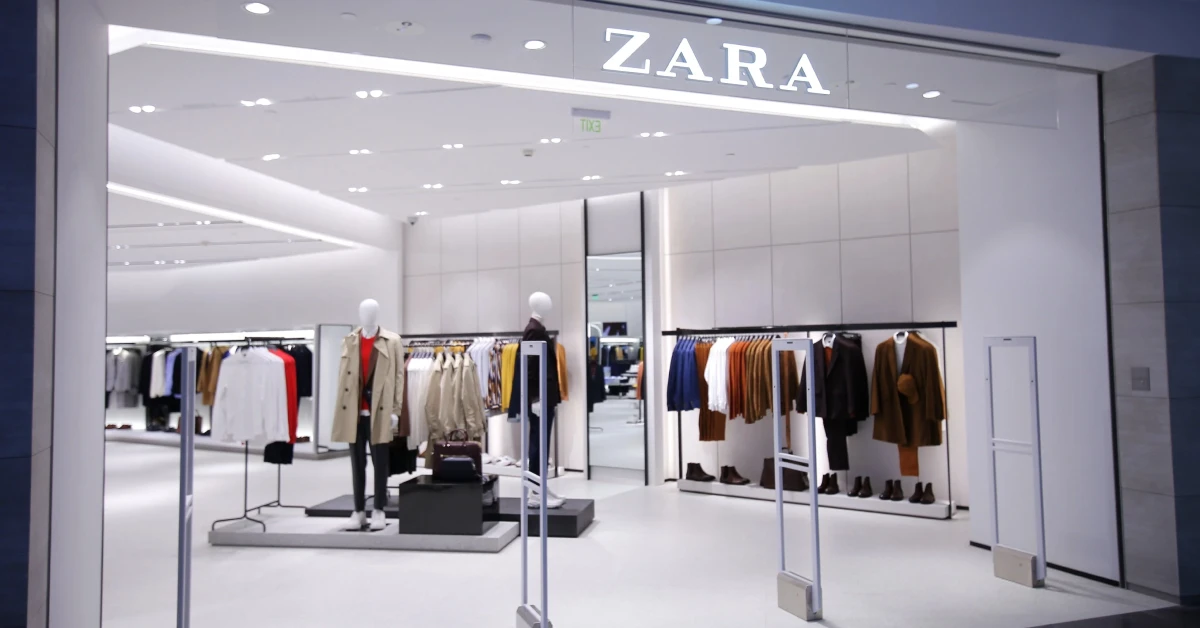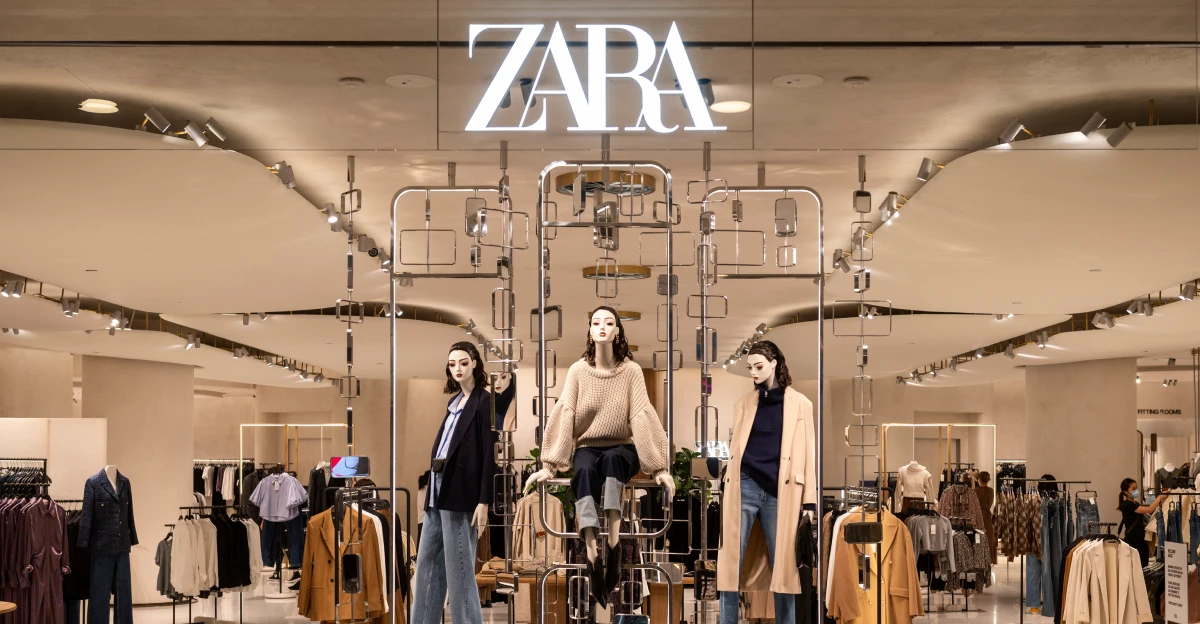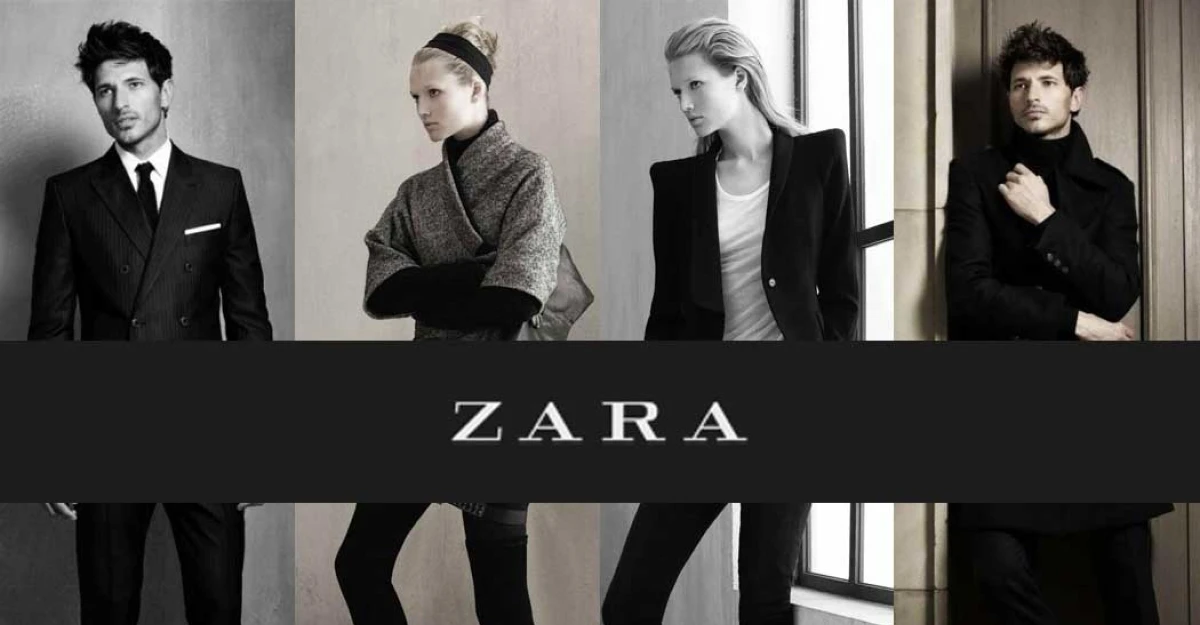You asked, and we listened! Get ready to dive into the fascinating world of Zara with our highly requested Zara Case Study.
Recently, Zara has been trending in Instagram reels and YouTube shorts for its funky model poses. You must have seen it too! Have you wondered what made this Spanish brand so famous?

You may say that Zara works on the concept of fast fashion, which makes it win in the competitive market.
Well, that’s true but it is not the only reason. Let’s uncover the secrets behind Zara’s success through the Zara Case Study.
Let’s begin!
(A) Zara: A Brief Overview
Zara, a notable name in the fashion industry, is a Spanish retailer known for its distinctive approach to clothing and accessories. Operating on a fast fashion model, Zara excels in swiftly adapting to evolving fashion trends, setting it apart in the market. With a vertically integrated process, the brand manages everything from design to production in-house, allowing for efficient and responsive operations.
You’ll find Zara stores globally, each offering a diverse range of trendy and affordable clothing for men, women, and children. The brand’s commitment to delivering fashion-forward pieces at accessible prices caters to a broad audience, reflecting its significance in the industry.
Do you know what is fast fashion?
Fast fashion is a business model characterized by quickly producing affordable, trendy clothing items to meet rapidly changing consumer demands.
Zara works in the same way. We will look into its details in the upcoming section. Before that, let’s go through the profile of Zara-
| Name of the Brand | Zara |
| Former Name | Zorba |
| Operating Industry | Retail |
| Founded | 1975 |
| Founders | Amancio Ortega, Rosalia Mera |
| Headquarters | Arteixo (Galicia, Spain) |
| Number of locations | 2,007 stores |
| Area Served | Worldwide |
| Products | Clothing |
| Revenue | €23.9 billion |
| Parent Company | Inditex |
| Competitors | Forever 21, Mango, Gap, Marks & spencer |
What makes Zara stand out is its ability to balance responsiveness in manufacturing, a well-structured supply chain, and a keen understanding of consumer preferences. This combination has established Zara as a trendsetting and influential player in the fashion landscape.
Its adaptability and dedication to making fashion trends accessible have solidified Zara’s place as a recognizable and influential name in the fashion industry.
(B) Zara Case Study: History & Evolution
Zara’s journey began with a dress-making factory called Inditex, established by Ortega in 1963. Over the years, Zara expanded its presence from Spain to Portugal and eventually to other European countries, the United States, and France.
Today, Zara boasts nearly 6,500 stores across 88 countries worldwide.
Let’s dive into the history of Zara in detail-
| Year | Milestone |
| 1975 | Zara was founded by Amancio Ortega in A Coruña, Spain, initially named ‘Zorba’ but later changed to ‘Zara’ due to a nearby bar with a similar name. |
| 1980s | Ortega transforms Zara’s design, manufacturing, and distribution process, emphasizing “instant fashions” using information technology and collaborative design groups. |
| 1985 | Zara opens its first international store in Porto, Portugal. |
| 1989 | Expansion into the United States, followed by entry into France in 1990. |
| 1990s | Further expansion to Mexico (1992), Greece, Belgium, Sweden (1993), and Israel (1997). |
| The early 2000s | Zara expands globally, entering Brazil (2000), Japan, Singapore (2002), Ireland, Venezuela, Russia, Malaysia (2003), China, Morocco, Estonia, Hungary, Romania (2004), Philippines, Costa Rica, Indonesia (2005), South Korea (2008), India (2010), Taiwan, South Africa, Australia (2011), and Peru (2012). |
| Sept 2010 | Zara launched its online boutique, initially in Jordan. |
| Nov 2010 | Zara Online extends services to Austria, Ireland, Netherlands, Belgium, and Luxembourg. |
| 2011 | Online stores commence operations in the United States. |
| 2014 | Zara introduces RFID technology in stores, using chips in security tags for inventory management. |
| 2015 | Zara ranks #30 on Interbrand’s list of best global brands. |
| 2019 | Zara updated its logo, designed by the French agency Baron & Baron. Despite a global decline in textile commerce, Zara’s business has risen by 2.17%. CEO Persson mentions plans to cut retail locations in Europe due to global rent considerations. |
| 2023 | Zara exits Russia, selling its business and rebranding to Maag. |
| Present | Zara operates nearly 3000 stores in over 96 countries, including kids and home stores, continuing its global expansion. |
Zara is the flagship brand of the Inditex group, which is one of the world’s largest fashion retail conglomerates.
The head office of Zara is located in Arteixo, in the province of A Coruña, Galicia, Spain. Inditex also owns other popular brands like Massimo Dutti, Pull&Bear, Bershka, and Stradivarius.
(C) Brand Philosophy of Zara
Do you know why Zara stands out among its competitors? Due to its brand philosophy! Sara’s success hinges on several key principles-
| Brand Philosophy | Description |
| Fashion-forward | It keeps up with the latest trends, ensuring that its collections are always fresh and relevant. |
| Quality | Despite being affordable, Zara maintains high-quality standards in its clothing and accessories. |
| Affordability | Zara strikes a balance between style and price, making it accessible to a wide range of consumers. |
| Rapid Trend Replication | Leveraging primary information technology, Zara swiftly replicates fashion trends. |
| Group Design Approach | Teams of designers collaborate on products, enhancing productivity. |
| Cost-Effective Materials | Zara uses affordable materials without compromising quality. |
| Competitive Pricing | Outsourcing production to countries with cost-effective labor. |
Zara’s strategy is strikingly different from traditional fashion retailers. Reason? Fast fashion concept and in-house production of clothes! Go through the next section for detailed information.
(D) Zara Business Model: Effective Working Strategies
In this section, we will dive into the business model of Zara to determine its working strategies that played a huge role in its success-
| Zara Business Model | Details |
| Fast Fashion Strategy | At the core of Zara’s business model is its commitment to fast fashion. Unlike traditional retailers, Zara rapidly responds to the latest trends, ensuring that new designs hit the shelves at record speed. This approach allows you, the customer, to access the most current styles without the typical delays in the fashion industry. |
| Vertical Integration | Zara takes control of every step in the production process, from design to manufacturing and distribution. By keeping everything in-house, Zara maintains a high level of flexibility, enabling quick adjustments based on customer feedback and emerging trends. This vertical integration contributes to the brand’s agility in the ever-evolving fashion landscape. |
| Limited Production Batches | Zara deliberately produces limited quantities of each design. This intentional scarcity creates a sense of exclusivity, driving demand. As a result, you encounter a frequently changing inventory, enhancing the allure of finding unique and in-demand pieces during every visit. |
| Just-In-Time Manufacturing | The “just-in-time” manufacturing approach ensures that Zara produces items only when there’s demand. This minimizes excess inventory and reduces the need for heavy markdowns, allowing you to enjoy reasonable pricing for trendy fashion items. |
| Data-Driven Decision-Making | Zara leverages data and customer feedback to inform its design and production decisions. By closely monitoring what resonates with you, the brand tailors its offerings to match your preferences, creating a more personalized and customer-centric shopping experience. |
| Global Synchronization | Zara synchronizes its operations globally, ensuring that the latest trends reach stores worldwide simultaneously. This synchronized approach reinforces the brand’s image of offering cutting-edge fashion on a global scale, catering to diverse customer tastes and preferences. |
Let’s dive into the details-
(D.1) Fast Fashion Model
Zara is known for its “Fast Fashion” approach. It releases new collections frequently, sometimes launching over 22 new product lines per year. This agility allows Zara to respond swiftly to changing trends and customer preferences.
- Rapid Trend Replication: Harnessing cutting-edge information technology, Zara excels at swiftly replicating prevailing fashion trends. This enables the brand to stay ahead of the curve, delivering the latest styles to customers promptly.
- Group Design Approach: Departing from the conventional individual designer model, Zara adopts a collaborative approach. Teams of designers work in synergy, fostering enhanced creativity and efficiency in product development. This collective effort ensures a diverse range of products aligned with dynamic market demands.
- Cost-Effective Materials: Zara strategically utilizes affordable materials without compromising on quality. This approach allows the brand to maintain competitive pricing while delivering products that meet or exceed industry standards. The focus on cost-effective yet quality materials contributes to Zara’s accessibility and broad customer appeal.
- Competitive Pricing: Zara optimizes its production costs by outsourcing to countries with cost-effective labor. This global approach not only supports competitive pricing but also facilitates the brand’s ability to swiftly adapt to market demands. The combination of efficient production and competitive pricing reinforces Zara’s position as a leader in the fast fashion landscape.
(D.2) Product Range

Let’s briefly look at its product range too-
- Clothing: From chic dresses and tailored suits to casual wear and activewear.
- Accessories: Including bags, shoes, belts, and jewelry.
- Beauty Products: Fragrances and cosmetics.
- Perfumes: Zara has its line of fragrances.
(D.3) Vertical Integration: In-House Operations & Logistics
Zara’s way of doing business centers on something called vertical integration. Here is how it works-
- Design: Zara takes charge of creating its designs, meaning it controls how its clothes look and stay on-trend. This ensures that what you find in Zara stores reflects the latest fashion trends.
- Manufacturing: Zara doesn’t just design; it also makes its clothes in-house. This is a big deal because it lets Zara make changes to its products fast. If there’s a new trend or customer feedback, Zara can respond quickly, which is pretty cool.
- Shipping and Distribution: Zara doesn’t stop at making the clothes; it handles everything from getting them to the store to making sure they’re sent to the right places. This full control of the supply chain ensures that the clothes you see in Zara are not only stylish but also reach the stores efficiently.
In short, the fast fashion concept, vertical integration, and supply chain efficiency helped Zara to achieve impressive milestones.
(E) Revenue Model of Zara: How does Zara make money?
Do you know Zara earned Rs.2,562.50 crore in India? That’s not all. It earned over 23 billion euros from its stores worldwide.
That’s quite amazing! Isn’t it?
But how does Zara earn such a whopping amount of money? Due to its impressive revenue model.
Let’s go through them one by one-
| Zara Revenue Model | Description |
| Retail Sales | Zara rakes in a substantial portion of its revenue through the operation of a whopping 2,007 stores spread across 96 countries. This massive retail network allows customers worldwide to access and purchase Zara’s trendy offerings. |
| Online Sales | Zara doesn’t limit itself to physical stores. The brand has a robust online presence, catering to a global audience through its e-commerce platform. This avenue expands Zara’s reach, enabling customers to shop conveniently from anywhere |
| Inditex Ownership | Zara is under the ownership of Inditex, the world’s largest fast-fashion group. This means that Zara is part of a significant player in the global fashion industry, benefiting from shared resources and expertise within the Inditex umbrella. |
| Market Capitalization | In 2020, Inditex, Zara’s parent company, held a market capitalization of an impressive $73.7 billion. This substantial valuation highlights Inditex’s influential position in the market. |
| Zara’s Value | As of 2022, Zara’s value soared to nearly $13 billion. This showcases the brand’s standalone worth within the larger Inditex portfolio, emphasizing its contribution to the group’s overall success. |
Let’s briefly dive into Zara’s finances for the years 2022 & 2021-
| Financial Aspects | 2022 (€ billion) | 2021 (€ billion) |
| Revenue | 23.9 | 19.7 |
| Profit before taxes | 4.0 | 2.8 |
| Return on Capital Employed (%) | 31 | 25 |
| Total Assets | 24.8 | 23.6 |
| Number of Stores | 2,312 | 2,489 |
| Share of stores franchised (%) | 13 | 12 |
That’s how Zara is going through its purple patch in terms of revenues!
(F) Zara Marketing Strategies
Zara, the renowned Spanish fashion retailer, has crafted a distinctive marketing strategy that contributes to its global success. In this section, we will delve into the key elements of Zara’s marketing approach-
(F.1) Fast Fashion Strategy
The fast fashion model functions as a highly effective marketing strategy for Zara in several ways. First and foremost, the rapid turnover of collections, with over twenty product lines per year, creates a sense of urgency and novelty for customers. This continual introduction of fresh styles not only keeps Zara top-of-mind but also fosters a dynamic shopping experience, encouraging frequent visits to discover the latest trends.
Moreover, the quick response to changing trends and customer preferences positions Zara as a trendsetter, appealing to fashion-conscious consumers. The ability to swiftly translate runway trends into accessible and affordable pieces reinforces Zara’s image as a go-to destination for staying in vogue.
Additionally, the limited production batches contribute to an atmosphere of exclusivity, prompting customers to make timely purchases to secure unique and in-demand items. This scarcity-driven approach enhances the perceived value of Zara’s offerings.
In essence, the fast fashion model serves as a powerful marketing tool for Zara by creating a sense of immediacy, exclusivity, and trend relevance, fostering customer loyalty and consistently attracting a diverse audience seeking the latest in fashion.
(F.2) In-Store Experience

Zara places a strong emphasis on crafting an exceptional in-store experience, carefully curating showrooms to exude an atmosphere that is both exclusive and professional. The meticulous design choices contribute to an ambiance that goes beyond a mere shopping space, creating an environment where customers feel engaged and inspired.
The meticulous attention to detail is aimed at ensuring that every aspect of the in-store setting is carefully considered, from layout to lighting.
This focus on the in-store ambiance goes beyond aesthetics—it becomes a vital part of Zara’s marketing strategy. The thoughtfully designed physical stores act as powerful marketing tools in themselves, drawing in customers by providing a memorable and immersive shopping environment.
By enticing shoppers to explore the latest trends in this carefully curated setting, Zara not only enhances the overall customer experience but also reinforces its brand image as a trendsetting and sophisticated fashion destination!
(F.3) Affordability & Differentiation
Zara strategically positions itself by prioritizing affordable pricing while maintaining a commitment to quality. This dual emphasis allows the brand to resonate with a wide range of customers. By providing stylish clothing at reasonable prices, Zara ensures accessibility, making fashion-forward designs attainable for a diverse audience.
The effectiveness of this marketing strategy lies in Zara’s ability to differentiate itself in the market. The brand stands out not only for its trendsetting designs but also for its adept balance of fashion-forward aesthetics and accessible costs.
This unique blend positions Zara as a go-to destination for those seeking both style and value, enhancing the brand’s appeal and solidifying its market presence. The affordability and differentiation strategy contribute to Zara’s ability to capture a broad customer base and maintain its status as a leading player in the competitive fashion landscape.
(F.4) Word of Mouth and Limited Advertising

Zara strategically leverages the power of word of mouth and customer recommendations as primary drivers of its marketing efforts. In a departure from traditional advertising-heavy approaches, Zara relies on the subtlety of customer satisfaction and positive experiences to promote its brand.
This unique strategy involves cultivating a strong and positive buzz around Zara’s collections, encouraging customers to share their experiences and recommendations. The reliance on word of mouth creates an authentic and organic promotion of the brand, fostering a sense of trust and credibility among potential customers.
The limited advertising approach doesn’t diminish Zara’s impact; rather, it aligns with the brand’s commitment to providing an outstanding in-store experience and quality products. The positive buzz generated by satisfied customers becomes a powerful force, driving foot traffic to Zara’s stores and contributing to the brand’s sustained success in the competitive fashion market.
(F.5) Social Media Marketing
Zara actively embraces social media platforms as a crucial component of its marketing strategy. The brand leverages platforms like Instagram, Facebook, and Twitter to engage directly with its audience, creating a dynamic online presence.
The strategy involves regular updates across these platforms, keeping followers informed about the latest arrivals, ongoing trends, and behind-the-scenes glimpses into Zara’s fashion world. By maintaining an active and visually appealing presence, Zara not only stays connected with its audience but also cultivates a sense of anticipation and excitement around its offerings.
In addition to direct engagement, Zara strategically collaborates with influencers. These collaborations amplify Zara’s reach, tapping into the influencers’ follower base and creating a ripple effect of brand awareness.
Through this multi-faceted approach, Zara effectively utilizes social media not just as a promotional tool but as a means to foster a dynamic and interactive relationship with its audience, contributing to the brand’s overall success in the digital landscape.
(F.6) Personalization & Community Engagement
Zara adopts a customer-centric strategy by customizing its offerings to cater to local tastes and preferences. This personalization ensures that Zara’s collections resonate with diverse communities, creating a more inclusive and relatable shopping experience.
Community engagement takes center stage in Zara’s approach. Events like fashion shows or store openings play a pivotal role in fostering a sense of belonging among customers. By actively involving the community in these events, Zara goes beyond being a retailer and becomes an integral part of the local fabric.
Crucially, Zara prioritizes customer feedback. Actively listening to what customers have to say, the brand adapts and evolves its offerings based on this valuable input. This responsiveness not only enhances the overall customer experience but also reinforces a sense of collaboration between Zara and its community.
In essence, Zara’s commitment to personalization and community engagement contributes to a brand image rooted in customer satisfaction and a genuine connection with the diverse communities it serves.
(G) Sustainability Efforts: Crucial Part of Zara Case Study
Do you know what Zara is famous for apart from fashion? Its sustainability efforts to preserve mother nature! Let’s look at the sustainability efforts of Zara-
| Zara Sustainability Efforts | Particulars | Details |
| Join Life Movement | Sustainability | Launched the Join Life movement to enhance sustainability. |
| Environmental Commitments | Set goals for 2030, focusing on areas like water conservation and reducing waste in landfills | |
| Chemical Bans | Actively working to ban harmful chemicals* from production processes. | |
| Transparency and Traceability | Score | Transparency score of 14%. |
| Good Part | Parent company Inditex shares supply chain traceability reports and conducts safety audits. | |
| Bad Part | Zara-specific details are often linked to Inditex, making it challenging to find specific information. Factory lists and audit results are not publicly available. | |
| Maker Well-being | Rating | 15/33 |
| Progress | While progress has been made in improving working conditions, the size and profitability of Zara should allow for better results. | |
| Compliance | Enforces a solid code of conduct and conducts audits to ensure compliance. | |
| Environmental Sustainability | Score | Scores below 50% for environmental sustainability. |
| Goals | It includes achieving net-zero emissions by 2040, adopting sustainable procurement for materials like cellulose fibers, cotton, and linen, and actively working on reducing waste in landfills. |
Thus, Zara is increasingly conscious of sustainability. The brand aims to reduce its environmental impact by using eco-friendly materials and promoting recycling. Such initiatives resonate with socially aware consumers.
(H) Challenges Faced by Zara
The journey of Zara was not free of challenges. Let’s look at some of the major challenges of Zara-
| Challenges | How does Zara address them? |
| Rapid Fashion Cycle | Zara embraces its fast fashion model but faces challenges in managing production speed. To address this, the brand invests in robust data analytics to predict trends accurately and streamline production processes, ensuring agility without compromising quality. |
| Supply Chain Complexity | Zara manages a vertically integrated supply chain. By owning and controlling every aspect, from design to manufacturing and distribution, Zara ensures flexibility and responsiveness, mitigating challenges related to external suppliers and logistics. |
| Global Expansion Pressures | Zara’s global expansion poses challenges in understanding diverse market preferences. To address this, the brand tailors its offerings to local tastes, engages in community events, and actively listens to customer feedback, ensuring relevance and resonance in varied markets. |
| Online Retail Competition | The rise of online retail intensifies competition. Zara counters this by investing in a robust online presence, regularly updating social media platforms, and collaborating with influencers to amplify reach and engage a digitally savvy audience. |
| Ethical Fashion Expectations | Growing expectations for ethical fashion practices pose challenges. Zara addresses this by incorporating a code of conduct, conducting audits, and continuously improving working conditions. The brand actively communicates its efforts to enhance transparency and traceability, aligning with evolving consumer expectations. |
| Balancing Sustainability and Profitability | Zara faces the challenge of balancing sustainability goals with profitability. The brand addresses this by setting clear sustainability objectives, such as achieving net-zero emissions by 2040 and sustainable procurement, while also investing in technology and innovation to ensure long-term financial viability. |
Zara brilliantly addressed those challenges to produce effective results that ultimately helped them grow their business.
(I) Summing Up: Zara Case Study
Zara’s remarkable success in leading the fashion market can be attributed to its unique blend of rapid fashion cycles, vertical integration, and a customer-centric approach. By staying ahead of trends with its fast fashion model, ensuring control over the entire production process, and tailoring offerings to local tastes, Zara captures a diverse and loyal customer base.
The brand’s commitment to affordability, engaging in-store experiences, and strategic use of social media further solidify its market leadership. Zara’s story showcases the power of adaptability, responsiveness, and a strong connection with customers in navigating the dynamic landscape of the fashion industry!


Apart from selling clothes and accessories at higher prices, still it is among the favourite ones for many!